Understanding TOFU, MOFU, BOFU is a foundational step in effective SEO.
In this article, you’ll learn what these terms mean. We’ll reveal our strategy playbook, which focuses on MOFU and BOFU.
And we’ll share a powerful framework to help you choose the right marketing and keywords to drive conversions.
But first, let’s cover some ABCs of TOFU, MOFU, and BOFU.
In This Article
What’s a Sales Funnel?
A sales funnel is a mental conception of prospects’ stages, from initial awareness of a product to purchasing it.
Ever since an advertising pioneer conceived of the AIDA model (Awareness, Interest, Desire, Action) in 1898, marketers have used funnel concepts to organize their thinking and outreach.
The sales funnel concept is simple, whether it’s called the buyer’s journey or a purchase funnel.
As your target audience gains awareness of your brand, a subset of those prospects will go on to consider what you offer. And a smaller subset will become customers.
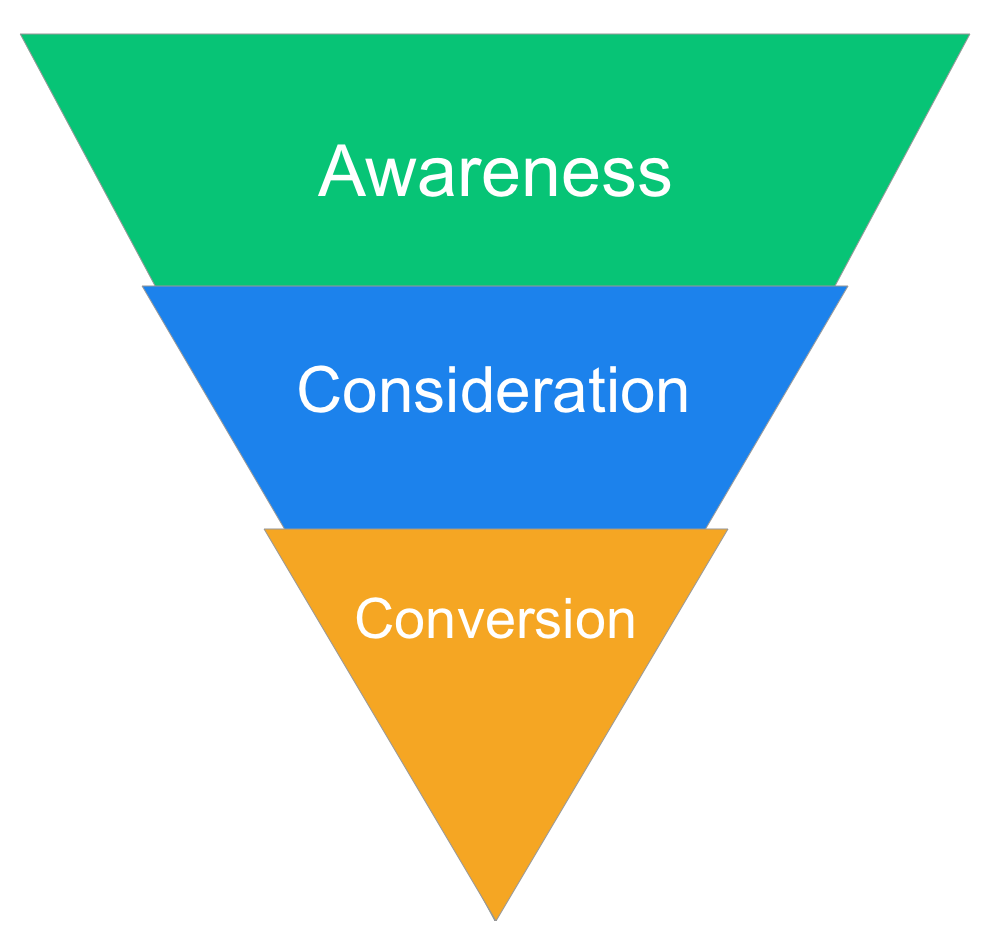
In today’s digital world, prospects rarely follow a straight line from awareness to purchasing.
Nevertheless, the funnel concept is useful. It highlights the fact that prospects have different information needs depending on the stage they’re in.
So, how do TOFU, MOFU, BOFU relate to this?
What is TOFU, MOFU, BOFU?
TOFU, MOFU, BOFU are acronyms that refer to the sales funnel stages.
- TOFU stands for Top of the Funnel
- MOFU stands for Middle of the Funnel
- BOFU stands for Bottom of the Funnel

These acronyms are popular with marketers and provide a short-hand way of referring to the funnel stages.
Understanding the Benefit of TOFU, MOFU, BOFU
The benefit of TOFU, MOFU, and BOFU is that it helps you think in a structured way about creating effective content for each stage.
- TOFU: How can I attract my prospect’s attention and make a great 1st impression?
- MOFU: How can I persuade my prospects to consider my products?
- BOFU: How can I convince them our solution is best?
Remember: prospects in each stage have different information needs and mindsets.
And typically, the time spent exploring your brand increases, as prospects shift to the next stage.
For good reason, these stages have often been compared to a formal meal, which starts with light appetizers, proceeds to a soup and salad, and then culminates in the entrée.
Appetizers: TOFU content can be light and brief. Think “content snacks” on Facebook or general information.
Soup and salad: MOFU prospects want more substantial content. They’re interested in what makes your product special or the best. What problems does it solve?
Entrée: In the final BOFU stage, would-be buyers are willing to consume more information. They want to know all the details, including those related to transactions.
How Our Approach Differs
Many articles on TOFU, MOFU, and BOFU focus on recommending specific media formats.
For instance, some recommend ebooks, podcasts, print magazines, white papers, and infographics for TOFU. Workshops and classes, downloads, and interactive content are recommended for MOFU. And so on.
However, these recommendations don’t apply to many businesses. Can you imagine a plumber or hairdresser running a weekly podcast? Or publishing a print magazine?
All are time-consuming to create. And podcasts are time-consuming to listen to. Perhaps not the best idea for a TOFU audience!
Instead, our approach is to share principles behind creating content that matches users’ stage-specific needs, and converts and delivers ROI.
Once you understand these principles, you can create your own playbook.
As mentioned, we’ll also share our playbook because it includes some evergreen principles that can benefit most small businesses.
Strategic Considerations
Before we dive into our playbook, there are 2 concepts we need to cover: channels and keywords.
Your choice of channels and keywords will dictate your success.
Principle 1: Match the Channel to the Stage
In addition to creating content suited to each stage, you’ll need to deliver that content via a marketing channel that’s effective for reaching that stage.
A “marketing channel” means type of marketing.
- SEO is a marketing channel
- Email is a marketing channel
- Social media is a marketing channel
So, how do you know which channels work best for the different stages?
Thankfully, marketing visionary Avinash Kaushik has sorted this out.
Drawing on his experience consulting for Fortune 500 brands across the globe, Avinash Kaushik reveals which marketing channels are most effective for the different stages.
These insights are contained in his See – Think – Do framework.
Here’s our version below, simplified.
Channel Diagram (Simplified version)

The first thing you’ll notice about this framework is that Kaushik renames the consideration stages from the prospects’ vantage point.
- Awareness becomes “See”
- Consideration becomes “Think”
- Conversion becomes “Do”
Then he matches each stage to the marketing channels most effective for reaching that stage.
For instance,
- SEO is effective for all stages
- YouTube works well for the Think (Consideration) stage
- Email works well for Think (Consideration) and Do (Conversion) stages
Now, if you’re wondering how advertising fits into this, here’s a diagram including ad types.
Channel Diagram (Includes Advertising)
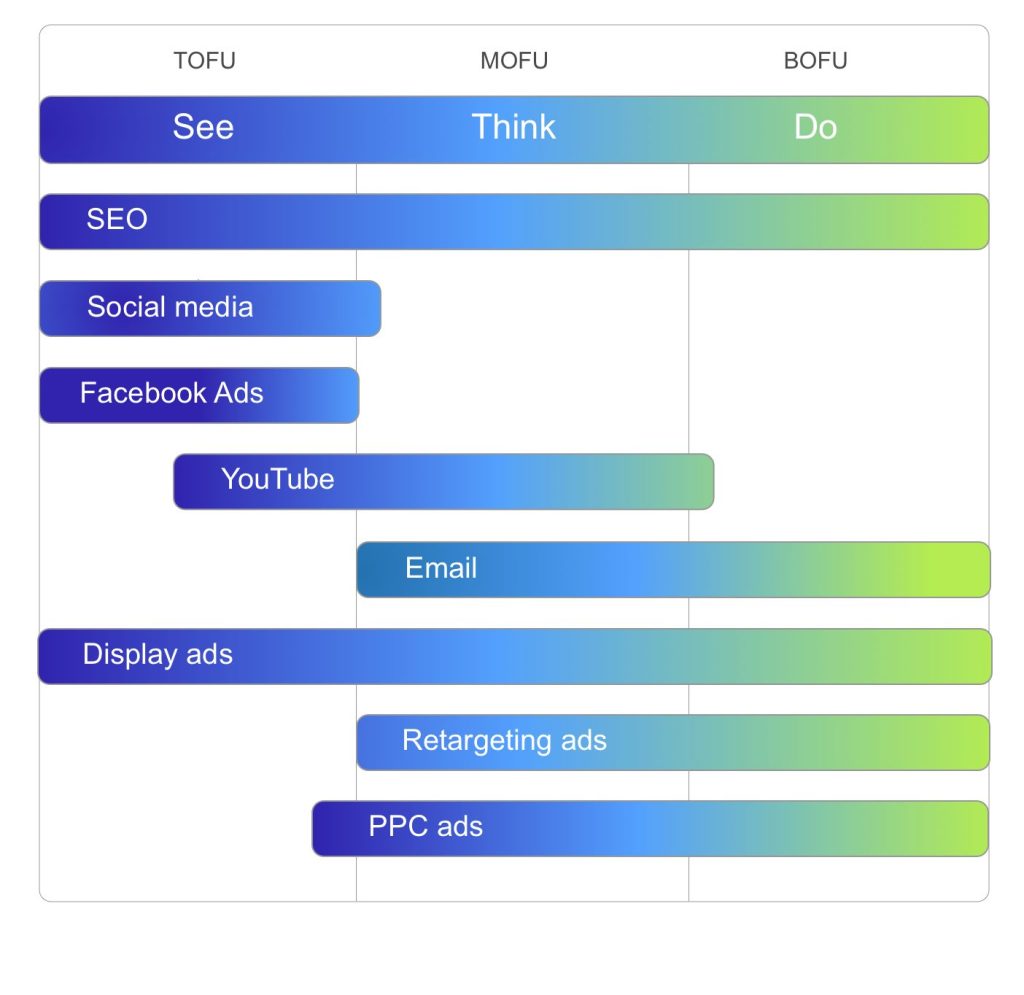
Now that we understand how to pick an effective marketing channel let’s turn our attention to choosing keywords.
Principle 2: Target Keyword Intent
You’re probably already aware that creating content based on a target keyword is a best practice in SEO.
But did you know you can find keywords to match each consideration stage?
Keyword research software, like Ahrefs and Semrush, labels keywords according to the perceived intent of the user.
- I is for Informational
- N is for Navigational
- C is for Commercial
- T is for Transactional
Informational (TOFU) keywords tend to be short, broad, and hard to rank for. The intent of the searcher is often not clear. They are in the initial stages of gathering information.
Examples of informational keywords are “SEO,” “literature,” and “planets.”
Navigational keywords typically contain a website or business name. Examples are “Home Depot credit card login,” “In-n-Out Burger,” or “Smithsonian Air and Space Museum.”
Commercial (MOFU) keywords signal some buying intent on the part of the searcher. They often compare products, read reviews, or search for “how-to” content.
Examples of commercial keywords are: “best SEO plugins,” “what is the best coating for metal roof?” and “Geico vs. Progressive.”
Transactional (BOFU) keywords indicate the searcher is on the brink of buying. They may seek booking, price, or shipping information, guarantees, or discounts. Or the keyword may include specific product attributes.
Examples of transactional keywords include: “Korean tacos near me,” “book a cruise from Tampa,” and “American-made M65 field jacket.”
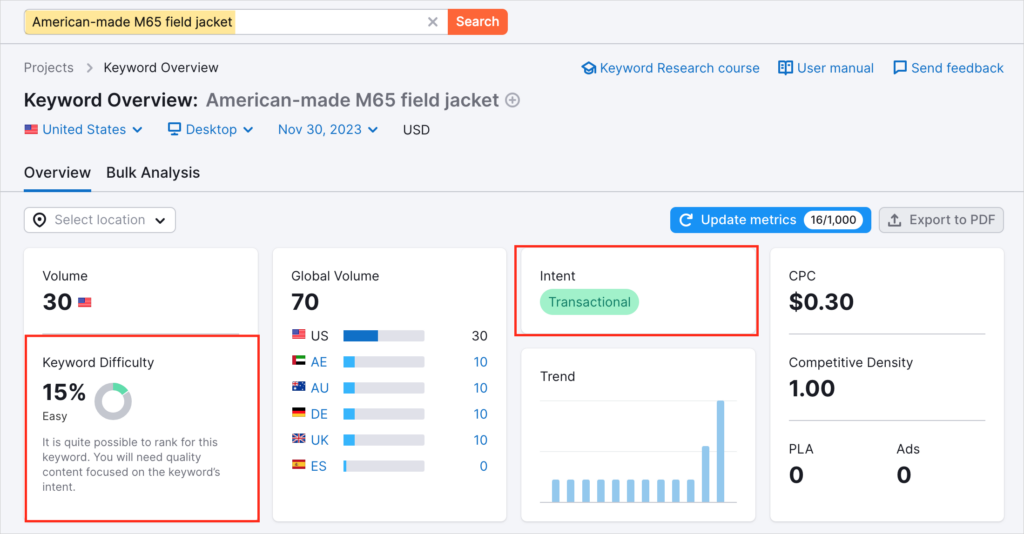
Remember that only Commercial (MOFU) and Transactional (BOFU) keywords signal buying intent.
Framework for Success
Now, let’s pull all this information together in a concise table.
| Stage | See (Awareness) | Think (Consideration) | Do (Conversion) |
| Marketer terms | TOFU | MOFU | BOFU |
| Keywords to target | Informational | Commercial | Transactional |
| Effective channels to use | SEO Social media Facebook Ads Display ads | SEO YouTube Display ads Retargeting ads PPC ads | SEO Display ads Retargeting ads PPC ads |
So how do we put this into action?
MOFU (Middle of the Funnel) and BOFU (Bottom of the Funnel) Strategy
Our growth playbook focuses on creating MOFU and BOFU content. That means most of our articles and YouTube videos are based on a MOFU (Commercial) or BOFU (Transactional) keyword.
While these keywords (topics) typically attract less traffic than Informational keywords, the traffic has commercial intent.
Not surprisingly, the conversion rates and sales are highest for MOFU and BOFU content.
And typically, these keywords are easier to rank for than Informational keywords. That means better ROI on your marketing spend.
These 2 tutorials will walk you through finding MOFU (Commercial) and BOFU (Transactional) keywords that are easy to rank for.
- Keyword Difficulty in SEO: What is it and How to Use it
- How to Find Low-Competition Keywords that Drive Conversions
As you’ll see in the tutorials, Semrush labels each keyword with one of the following descriptors.
- Very easy
- Easy
- Possible
- Difficult
- Hard
- Very hard
If a keyword you research turns out to be “Hard” to rank for, simply click the Keyword Magic button in Semrush and you’ll get hundreds if not thousands of easy variants to choose from.
If your website is new, or you aren’t ranking for much, it’s crucial to choose keywords that are rated Very easy, Easy, or Possible.
Now, let’s look at some MOFU and BOFU content examples. What type of content meets the needs of prospects in these stages?
MOFU and BOFU Content Examples
Remember, searchers using Commercial (MOFU) or Transactional (BOFU) keywords vary in buying intent.
They may have a vague, or thorough, idea of the problem they’re trying to solve. And they search for “how-to” content in order to solve that problem.
Using content to help prospects solve problems, will drive sales and revenue.
Keep in mind that MOFU searchers compare products or services. They’re trying to make up their mind about which is best.
Here are the 3 types of MOFU/BOFU content we create.
Let’s look at each one.
1. Comparisons: Moving Decision-Making Forward
Comparison articles are straightforward: they compare one solution to one or more alternatives.
A popular format for comparisons is the “versus” article. The keyword will be a comparison of 2 brands or types of product, like “Geico vs. Progressive” or “PandaDoc vs. DocuSign.”
Here are some examples of “versus” articles.
- Yoast vs Rank Math vs All in One SEO: Which Is Better?
- Yoast SEO vs All in One SEO: Which Is the Best SEO Plugin?
- WPForms vs Gravity Forms vs Formidable Forms: Which is Best?
- Acrylic Vs. Elastomeric Paints: Which Is Most Recommended?
- Metal Roofs vs. Shingles: Which is Right for You? Pros and Cons
A key benefit of creating “vs.” articles that feature your business name, is your brand will show up in searches for your competitors.
This can help you get traction and capture market share from those competitors.

In the example above, SignHouse compared their product to the better-known PandaDoc and Docusign.
As a result, the SignHouse article appears in searches for “pandadoc vs docusign” and searchers discover there’s a low-cost alternative to those more prominent brands.
Additionally, SignHouse has a page that compares their product to DocuSign. The page is ranking #1 for “docusign vs signhouse.”

You can also compare services or products you offer, as we see in this article.
2. How-Tos: Solving Problems
How-tos are very popular, and they’re big money-makers.
To create a how-to, show how your product or service solves a prospect’s problem.
To help with brainstorming, create a list of verbs to add after “How to” such as:
- How to Add . . .
- How to Choose . . .
- How to Create . . .
- How to Find . . .
- How to Fix . . .
Once you’ve drafted a list, consider running those keywords through a research tool like Semrush or Ahrefs. Verify that the keywords are easy to rank for and have Commercial or Transactional intent.
In addition to publishing how-tos on our blog and on YouTube, we recently began publishing SEO case studies. These are all “how-tos” and feature small businesses that have achieved impressive traffic growth.
Examples of how-tos from our business and other websites:
- How a Car Seat Safety Website Grew Traffic by 362% in 6 Months
- How to Submit Your Website to Search Engines
- How to Log Into Google Analytics (Step-by-Step)
- How to Patch and Repair Drywall
- How to Compare Two Columns in Excel
- How to Prevent Frozen Pipes During this Brutal New England Winter
- How to Make Béarnaise Sauce
- How to Learn Python (Step-by-Step)
- How to Plan a Perfect Trip to India: Real Tips from First-Hand Experience!
3. Showcases: Listicle Mini-Reviews
Our “showcase” articles are listsicles that describe our solution and our competitors’.
Each product is reviewed briefly with a focus on key differentiators.
Examples of showcase articles from our site and others:
- 6 Best WordPress Form Plugins
- 7 Best Electronic Signature Apps
- Top 10 Side Sleeper Mattresses
- 13 Best Free WordPress Plugins to Build a Budget-Friendly Website
- Top Kayak GPS Devices for Confident Navigation in 2024
- 6 Easy Robotics Projects for Beginners to Kickstart Your Journey
Showcases often include numbers in the title as well as adjectives like “best,” “easy,” “top,” or “budget.”
You’ve probably noticed that affiliate marketing sites use this tactic too.
Comparison tables are popular in both “versus” articles and showcases. If you include a table, narrow the feature list to avoid overwhelming users. And highlight differences.
Listing pros and cons is another way to help readers choose. As with comparison tables, keep these points to a minimum. Why? Site visitors often scan articles, rather than reading them word-for-word. Highlighting a few key points supports this scanning behavior.
Once you’ve created MOFU and BOFU content, you’ll be ready to deliver that content via an effective channel, like SEO and email marketing.
MOFU and BOFU Channels
Effective channels for MOFU and BOFU are SEO, email marketing, and YouTube.
Display ads, retargeting ads, and PPC ads are also effective, but not every business has an ad budget.
Using multi-channel marketing automation? This is effective for MOFU and BOFU as well.
SEO and YouTube: Our MOFU-BOFU playbook focuses on publishing SEO-optimized articles on our website and creating YouTube videos.
Email marketing: We also promote that content via email marketing and run sales campaigns.
Remember that we said MOFU prospects are interested in reviews? This is a reason why we include customer testimonials in our sales emails.
Keep in mind, content that doesn’t rank, can still generate revenue via email marketing.
PPC ads: We also do a small amount of PPC (pay-per-click) search advertising.
As you can see from the diagram above, the channels we’ve selected are among those described by Kaushik as most effective for reaching MOFU and BOFU prospects.
TOFU (Top of the Funnel) Strategy
We left TOFU to the end because our playbook emphasizes MOFU and BOFU. But we certainly do create content based on TOFU (Informational) keywords. And you probably will too.
Brand awareness is the goal of TOFU content. These prospects are finding out about your brand for the 1st time. Keep your TOFU content brief but appealing.
Another helpful analogy for creating TOFU content is meeting people at a party.
- You want to make a great first impression.
- And you don’t need to say much.
- Great visuals are memorable.
Do keep in mind that Informational (TOFU) keywords tend to be broad and hard to rank for. So be careful. It’s easy to waste resources creating content that never ranks.
(Learn how to find keywords that are easy to rank for.)
TOFU Content Examples
To come up with TOFU content ideas, think about your broadest prospect pool. What overlaps are there between what you offer and questions or interests they might have?
Answer Questions
Questions are popular TOFU topics. Many of our informational articles are based on question keywords, like: What is a Plugin? or What is Indexing?
Definition articles are common: these take a term (like “cool jazz”) and explain it. Definition articles are similar to “What is” content.
General How-Tos
In addition, some how-to keywords are labeled in Semrush as Informational (TOFU).
Examples are “how to learn SEO” or “how to tie a tie.”
These how-to keywords tend to be less specific than those that are labeled Commercial.
In addition, some TOFU articles take a light approach to attract readers. An example is: 5 Creative (and Hilarious) Content Examples Written by AI which targets the Informational (TOFU) keyword “written by AI.”
Statistics and Trivia
Statistics articles are also popular along with short trivia-based content or anecdotes.
Here are some examples of TOFU content:
- What is Cornerstone Content?
- What is “Starting Strength”?
- What is Social Proof? (and How Do You Use it in Online Marketing?)
- What is An Exit Page (and How to View it in Google Analytics)
- 29 Link Building Statistics to Help Power Your SEO Strategy
- 17 Online Review Statistics You Need to Know
- 8 Winter Driving Statistics Every Reader Needs to Know
- Cool Jazz: A Guide to the History and Sound of Cool Jazz

TOFU Channels
SEO and social media are effective channels for raising brand awareness, which is the goal of TOFU.
Facebook is widely used to boost brand awareness. X (formerly Twitter) is popular with certain niches like SaaS and food trucks. Feel free to experiment with these, and other social media platforms.
Effective TOFU advertising channels include Facebook Ads, display ads, and, to some extent, PPC ads.
Of these, Facebook Ads are perhaps the most effective for growing a community around your brand. That’s because you can build custom audiences based on interests, then interact with your prospects.
For example, say you sell cowboy hats. You can build a Facebook Ads audience of people who’ve liked pages about rodeos, country music, westerns, the Cowboy Channel, and cowboy boots.
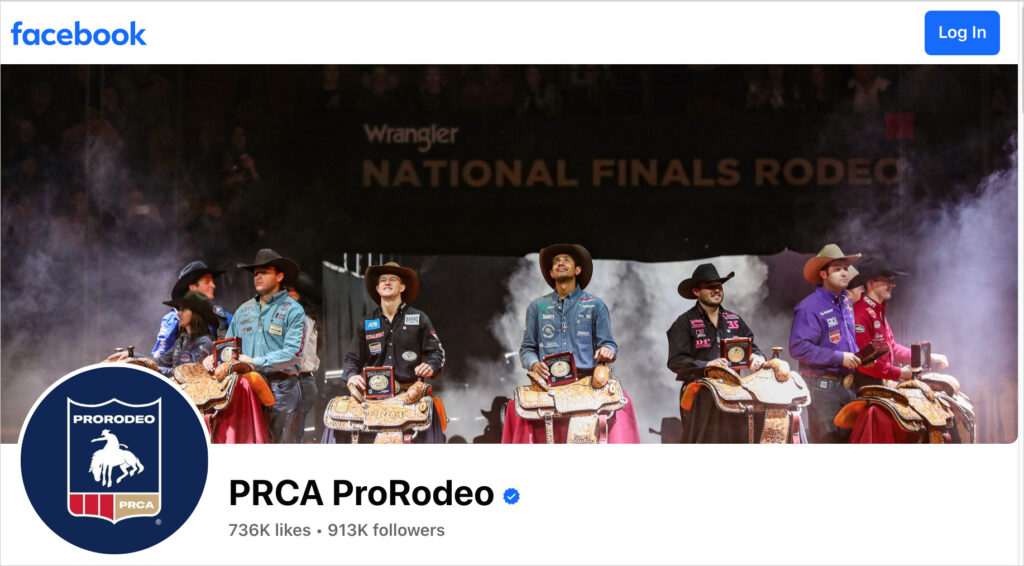
The ultimate goal is to entice your Facebook fans to visit your website so they can read your TOFU content and you can capture their contact information.
On-Page SEO: Essential for Ranking and Revenue
After creating your TOFU, MOFU, BOFU content, you don’t want to leave anything to chance. This is where on-page SEO comes in.
This simple habit will transform your SEO results.
Optimizing your page helps Google understand it better and rank it for relevant keywords.
This is why on-page SEO is the crucial last step for content marketing success. And you’re about to learn how easy it is to do.
All in One SEO: An Automated SEO Assistant
You can optimize your page for better Google rankings by using a WordPress plugin.
We recommend using All in One SEO (AIOSEO). This beginner-friendly WordPress plugin takes a lot of the guesswork out of SEO.

With over 3 million users and thousands of 5-star reviews on WordPress.org, AIOSEO is an established plugin with a track record of small business success.
There are 3 features in particular that will help your TOFU–MOFU-BOFU content rank.
- Automated On-Page SEO checks: AIOSEO will analyze your pages and provide specific actions steps to improve your SEO. As you act on the recommendations, your SEO score goes up.
- Schema Generator: Easily add schema markup to pages so Google understands your page better and can rank it for relevant queries.
- AI-Powered Link Assistant: Speed up internal linking, which can improve the rankings of your most important product or service pages. (Internal linking is one of the most overlooked SEO tactics.)

These additional AIOSEO features also help small businesses stand out.
- Sitemap Generator: Get 100% maintenance-free sitemaps created according to Google’s recommendations.
- Local SEO: Small businesses can get a headstart on ranking by using this simple feature.
- Rank Tracking: See how you’re ranking in Google without leaving WordPress. This SEO Statistics feature is an integration with Google Search Console.
- Google Algorithm Updates: See the impact of Google algorithm changes on your content.

TOFU, MOFU, BOFU Strategy Review
We covered a lot, didn’t we? How about a quick review?
Here’s a final version of the table.
| Stage | See (Awareness) | Think (Consideration) | Do (Conversion) |
| Marketer terms | TOFU | MOFU | BOFU |
| Keywords to target | Informational | Commercial | Transactional |
| Effective channels to use | SEO Social media Facebook Ads Display ads | SEO YouTube Display ads Retargeting ads PPC ads | SEO Display ads Retargeting ads PPC ads |
| Content types | Content “snacks” “What is” (definitions) General How-Tos | Comparisons Reviews How-Tos | Comparisons Reviews How-Tos |
- Use Semrush or Ahrefs to find and pick TOFU (Informational), MOFU (Commercial), and BOFU (Transactional) keywords that are easy to rank for. (Focus mostly on MOFU-TOFU keywords.)
- Make each keyword the main topic of a new content piece.
- Create light “information snacks” for TOFU; comparisons, how-tos, or showcase listsicles for MOFU and BOFU.
- Optimize articles for SEO.
- Use email marketing to promote content and earn sales.
- Use testimonials to convince MOFUs.
- Include countdown timers and special discounts to entice BOFUs.
- Use SEO to target all stages, social media to target TOFU, and YouTube to target MOFU.
Q&A on TOFU, MOFU, and BOFU
To be effective, do I need to use a lot of marketing channels?
We recommend that small businesses keep their marketing channels to a minimum. It’s easy to think “more” is better, but it’s the effectiveness of the channel that matters, more than the quantity of channels.
As mentioned, we focus primarily on SEO, YouTube, and email. And this has been more than sufficient to drive consistent growth.
How do TOFU, MOFU, and BOFU relate to topic clusters?
Since MOFU and BOFU keywords tend to be easier to rank for, creating cluster pages based on such keywords is an effective way to build topic clusters. Additionally, the main pillar page may be TOFU, but ranking for the subtopic pages will help the pillar page rank.
Learn more in our guidance on topic clusters.
What is multi-channel marketing automation and how does it fit in with TOFU, MOFU, BOFU?
Multi-channel marketing automation uses software to create customized messaging based on how users interact with it.
For example, you can use Ortto (formerly called Autopilot) to build communication sequences that use Facebook, SMS, email, print postcards, in-app messaging and more.
The next message in any sequence is determined by the user’s behavior.
This is an effective way to provide a seamless CX (customer experience), where each message fits the interests (and behavior) of the user.
This approach can have a powerful impact on moving prospects to the next stage of the sales funnel. And platforms like Ortto typically include lead scoring, which enables you to prioritize leads most likely to buy.
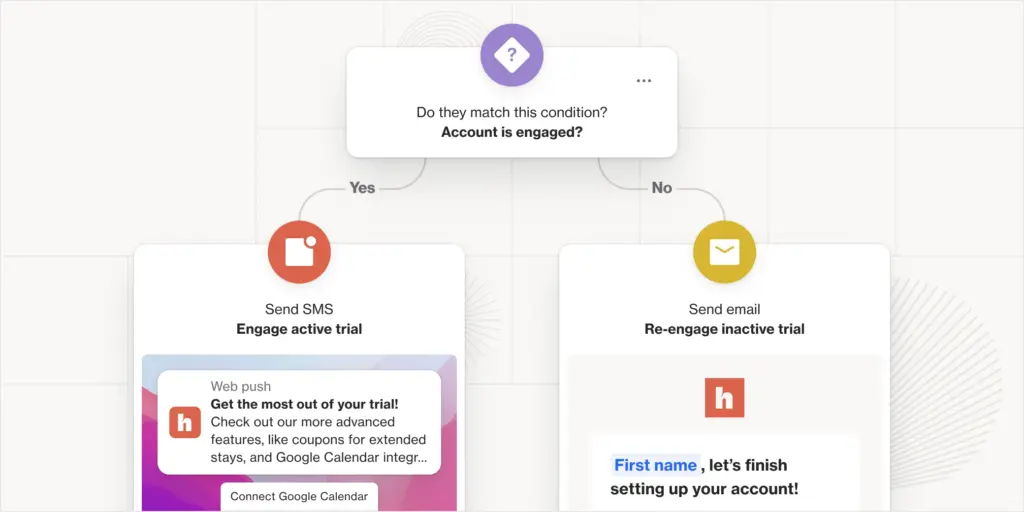
Resources on Content Marketing and SEO
- 7 SEO Secrets Used by the Pros to Grow Revenue
- How to Find Low-Competition Keywords that Drive Conversions
- Keyword Difficulty in SEO: What Is It and How to Use It
- Topic Clusters: The Secret Weapon of SEO Pros
- How to Track SEO Keyword Rankings in WordPress
- How to Create a Lead Magnet (a Step-by-Step Guide + Examples)
After TOFU, MOFU, and BOFU . . .
We’ve shared guiding principles so you can create your own TOFU – MOFU – BOFU playbook.
Once you know how to think in a structured way about your audience’s consideration stages, you have a blueprint to work from.
Two final suggestions:
- Keep it simple: It’s easy to complicate things.
- Experiment: Try different things; see what works.
And remember, SEO is effective for reaching prospects in all stages.
Next, explore the role of backlinks in driving SEO results. And learn how internal link building is connected to rankings.
To learn more about search engine optimization, subscribe to our YouTube Channel. Each week, we publish new step-by-step tutorials there.
And follow us on X (formerly Twitter), LinkedIn, or Facebook to stay in the loop.
Disclosure: Our content is reader-supported. This means if you click on some of our links, then we may earn a commission. We only recommend products that we believe will add value to our readers.
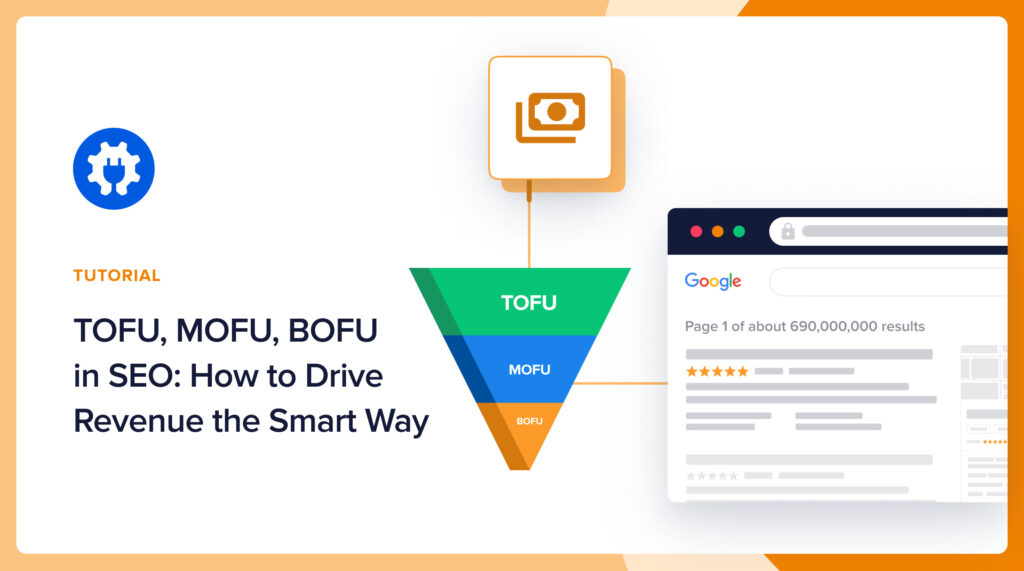

A great reminder of the marketing channel.
I got useful information and shared the post
Hi Peter! Thanks for the feedback. So glad this was useful for you.
Love your approach to driving revenue intelligently! Your tips offer a refreshing perspective, focusing on sustainable growth and long-term success. Excited to implement these strategies and see positive results. Thanks for sharing your wisdom!
Delighted to hear this was useful, @ Webtoniq! Looking forward to hearing your success stories.